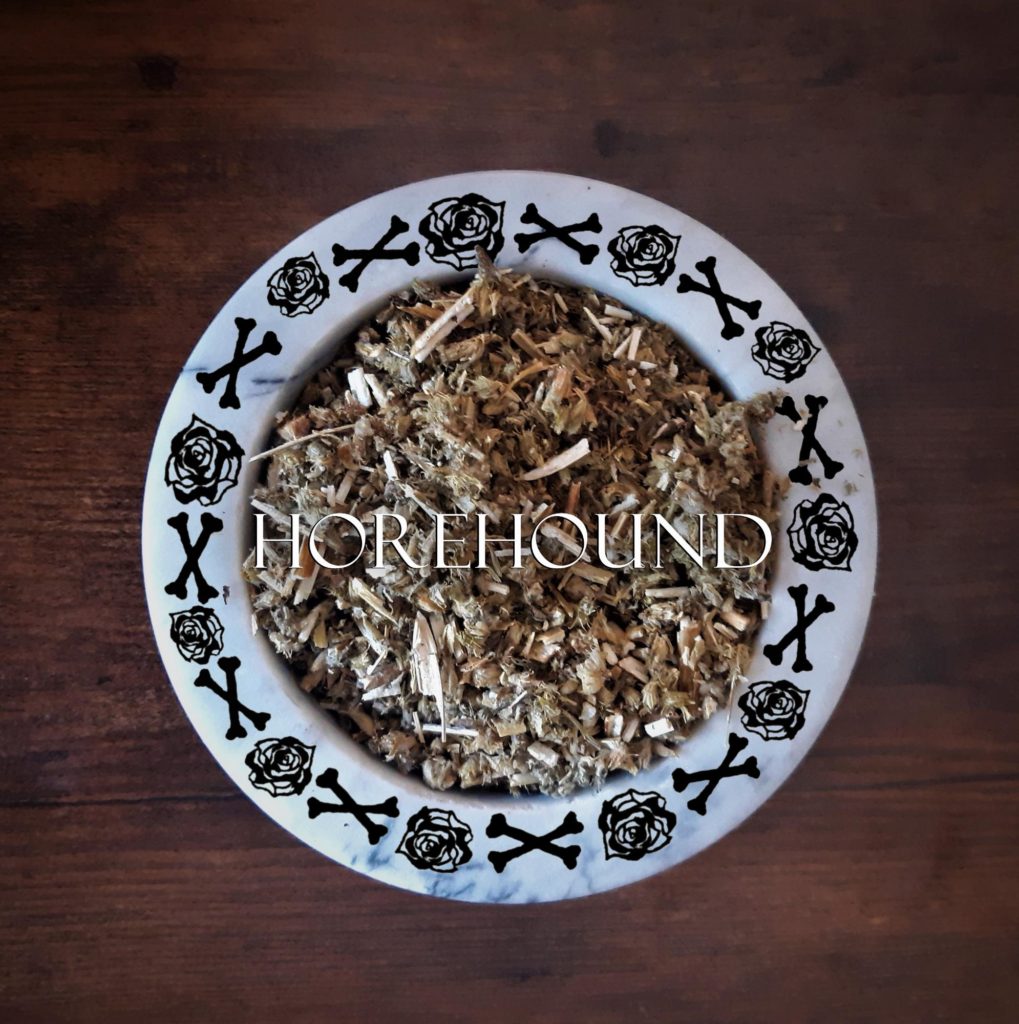
Horehound, is probably not the name you would think of for a highly respected plant in herbalism.
However, this mighty green spirit has some power behind its name and it’s definitely not derived from promiscuous hounds.
This Th-HERBS-day we honor horehound (Marrubium vulgare).
It is a member of the mint (Labiatae) family and has been used for almost every illness throughout history.
Horehound has long been thought to break hexes and spells.
Its name comes from the Egyptian god of the sky and light, Horus.
During the Jewish holiday of Passover, horehound is one of the bitter herbs traditionally eaten as a reminder of the bitter times of the enslaved Israelites.
Mercurial herbs aren’t usually thought of as having strong protective properties.
Horehound, on the other hand, is like the final boss in a game if the level was based on Mercury-ruled plants.
It’s a beast when it comes to keeping out unwanted energies and even has exorcism properties.
This mainly stems from its ability to help open the brow chakra in a way that invites the light of the Sun (or Horus), into the body to drive away negative energies attached to the body.
Not only is it a powerfully protective herb, but it is also amazing to work with to connect to ancestors and guides.

The History and Use of Horehound
Horehound is primarily used as a decongestant and expectorant in today’s medicine.
However, this herb was once highly revered for the belief that it treated everything from rabies, and tuberculosis, to jaundice, and hepatitis.
Today, the medicinal properties have been consolidated to being used for cough syrups and soothing bronchial ailments like chest colds and bronchitis.
One herbalist from the Wild Medicine School YouTube channel highly reveres horehound for its effectiveness in treating skin ailments.
In the video titled “Medicinal Uses of Horehound,” one herbalist describes the importance of spreading the word of horehound’s effects against MRSA.
In ancient times, the herb was praised for its use as an antidote to wolfsbane.
Ninth-century monk, Walafrid Strabo stated;
“…And if some evil stepmothers mix up poisonous substances and slip them into your drink, or deceptively load lethal wolfsbane into your food, then quickly down a draught of the antidote horehound and you’ll be soon rid of the anticipated dangers.”
The Modern Herbal Dispensary, by Thomas Easily and Steven Horne, notes the herb’s effect as a cough syrup or lozenge.
It states that horehound drops can still be found in stores today and that the herb increases the secretion of thinner mucus.
This thinner mucus helps break up congestion and is a great remedy for coughing, wheezing, and difficulty breathing.
Horehound has also been widely used for its ability to stimulate digestion.
Today you can find it in the widely sold cough drop brand Ricola as an active ingredient.

The Spirit of Horehound
The spirit of horehound is one that leaves no stone unturned when you put it to work.
It will help you discover your power, open your third eye, and help you get in tune with your ancestral gifts.
This herbal spirit is amazing to work with during psychic development.
It’s no coincidence it is named after the Egyptian god Horus because of its amazing third-eye-enhancing properties.
The eye of Horus hieroglyph is derived from the pattern around the pineal gland in the brain, aka-your third eye.
It will assist in energetic clearings, home exorcisms, protections, and rid of any unwanted attachments to your aura.
This plant spirit resonates with the energy of Virgo and Ketu in astrology.
If you’re wanting to get to the bottom of something, or are on a deep research mission, horehound can help guide you.
Your conscious mind can hold many thoughts that may hold you back from being fully present in your practice.
You may even unknowingly manifest some of these thoughts in ways that may sabotage your spell work.
This is where Mercury herbs can be your best ally in witchcraft, especially this herbal heavyweight.
Horehound is particularly good with knocking out dense energy so you can have plenty of room to breathe, focus, and expand your awareness.
When crafting to get in touch with your ancestors, burning horehound as a smudge can help your aura meet those energetic frequencies.
It is a powerful ingredient in kitchen witchery, especially when used around Passover.
Using both the Jupiterian herb hyssop and horehound together can make for an effectively powerful protective team to deter strong dense energies.
This protective duo can be hung in doorways, trees, and perimeter fences, or blended into oils to anoint windows and doorways.

Horehound’s Energetic Properties
This list of properties is a helpful guide to assist you in spell crafting and rituals.
The energy of the herb is heightened when planned carefully with corresponding days, seasons, zodiacs, etc.
Here are 18 energetic properties associated with horehound:
1. Planet: Mercury
2. Zodiac Sign: Gemini, Virgo
3. House: 3rd and 6th
4. Element: Air
5. Gender Energy: Masculine
6. Chakra: Vishuddha/Throat (Blue) and Manipura/Solar Plexus (Yellow)
7. Archangel: Raphael
8. Deity: Horus (Egyptian), Budha, Ketu (Hindu), Hermes, Hades (Greek), Freya, Freyr, Sif (Norse), Turms (Etruscan)
9. Sabbat: Beltane, Litha, Lughnasadh
10. Season: Summer
11. Day: Wednesday
12. Body: Nervous System, Bowels, Hands, Arms, Shoulders, Collarbone, Tongue, Sight, Perception, Understanding, Interpretation, and Expression
13. Rune: Raidu, Kauna, Isa, Jera
14. Numerology: 5
15. Fae: Fairy
16. Major Arcana: The Lovers, The Magician, The Hermit
17. Minor Arcana: Swords
18. Cartomancy: Spades

Growing Horehound
Horehound grows easily and can prosper in poor, dry soil, and with little water.
In fact, this herb can survive off as little as 12 inches of water in an entire season.
True to the nature of mint family members, horehound can easily take over the garden if left unattended.
It also has little to no pests and can help deter them from coming near other garden plants.
Native to Mediterranean climates, this dry climate herb is low maintenance and doesn’t do well with too much water.
So be careful not to over-water your horehound or it could die off before harvesting.
Sow seeds in early spring, placing them about 1/8in deep in the soil.
You may consider keeping your horehound in containers or separate raised gardens near the outer perimeters of the gardens.
This will help keep it from overtaking other plants and assist in keeping pests away.
Horehound produces flowers in the second growing season.
You can harvest the herb during its first growing season in the late summer but only take about a third of the top growth.
To retain the herb’s potency, chop the leaves immediately after harvesting and let them dry indirectly from sunlight.
As soon as the leaves are dry, store them in dark sealed containers, label them, and place them in a cool dark room.
Happy Th-HERBS-day!

